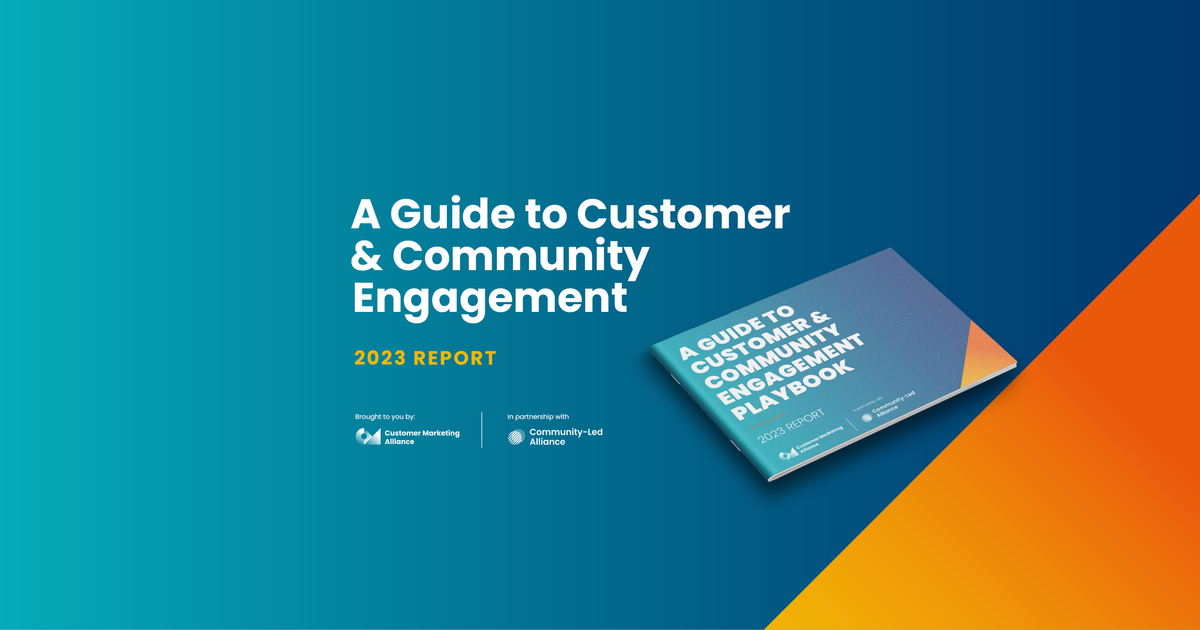What is the point in marketing if you’re not engaging your target audience? It’s like mailing a letter without a stamp, or brushing your teeth without toothpaste – you just wouldn’t do it!
Engagement marketing is a customer marketer’s bread and butter. When employed by a customer marketer, It’s about connecting with your customer base and creating meaningful experiences that foster brand loyalty.
Did you know that 58% of customers say they leave a brand because they just don't feel valued anymore? So, all of that hard work that's gone into acquiring that customer is lost because they just don't feel valued. There's no engagement with them. Where’s the sense in that?
That’s why customer marketing and engagement marketing go hand-in-hand: both are geared toward making exceptional experiences that translate into customer retention and advocacy.
Throughout this guide, we’re going to delve into the inner workings of engagement marketing, and unpick the following to help you succeed in your customer marketing journey:
- The definition of engagement marketing
- The subtypes of engagement marketing
- Why engagement marketing matters
- Key strategies in engagement marketing
- Tools and technologies for engagement marketing
What is the definition of engagement marketing?
Sure, you could say, “But ALL marketing is engagement marketing, right?” Well, yes and no. Engagement marketing can sometimes be referred to as “experiential marketing,” seeking to create meaningful, emotion-filled interactions. It veers away from traditional marketing to provide sensory, cognitive, and more complex experiences.
Did you know that 66% of consumers will abandon a brand if they don’t get a personalized experience? Personalized, engaged marketing cannot be slept on – it’s critical for the sustained success and repeated business of your customers.
The subtypes of engagement marketing
To make engagement a bit clearer, it's sometimes broken down into four subtypes:
- Reactive engagement
- Proactive engagement
- Emotional engagement
- Social engagement
When it comes to engaging your audience, whether your existing customer base or members of a community, you’ll find that the techniques involved to keep them galvanized aren’t always the same.
Understanding the distinctions between customer engagement and community engagement is crucial for crafting effective strategies. While both share common ground in fostering relationships, they serve distinct purposes and require tailored approaches.

Customer engagement vs. community engagement
- Customer engagement
- Increases customer retention
- Drives customer advocacy
- Enhances customer experience
- Boosts customer lifetime value
- Community engagement
- Empowers members
- Promotes social inclusion
- Facilitates problem-solving
- Promotes resource sharing and collaboration
- Builds trust and belonging
Customer engagement focuses on the relationship between a business and its customers, aiming to enhance satisfaction, retention, and loyalty through personalized interactions. Strategies like personalized content, excellent customer service, and loyalty programs are key in this area.
On the other hand, community engagement centers around building relationships within a community – whether it's customers, users, or other stakeholders. It aims to create a sense of belonging and shared purpose, empowering members to participate in decision-making and problem-solving. Events, forums, and social media groups are common strategies used here.
Understanding these differences helps in applying the right type of engagement strategy, whether you're focusing on deepening customer relationships or fostering a vibrant community.

Now, let's explore the four subtypes of engagement marketing in detail, each playing a critical role in how you connect with your audience:
Reactive engagement:
Reactive engagement is where a customer reaches out to a company, and the company responds. In this instance, the customer is making the first move and the company is triggered by this engagement. Examples of this include reaching out to customer support via Twitter with a complaint, or by posting a review on TripAdvisor, Yelp, or Google Reviews and the company responding.
Depending on how quickly you respond to a customer and how swiftly you resolve the issue, this type of engagement is key to sustaining a positive brand image and customer satisfaction.

Proactive engagement:
Proactive engagement, on the other hand, is when a brand reaches out to the customer without them making the first move. This type of engagement is ideal in cultivating strong relationships as it anticipates the customer’s needs before they’ve made contact.
Spotify is excellent at this type of engagement, using AI to curate personalized playlists and recommendations based on users’ listening history.

Emotional engagement:
Now this type of engagement is second to none. Eliciting genuine emotions from your target audience is the bedrock of marketing. Emotional engagement marketing tears up the rule book and transactional nature of business, building a deep, emotional bond between the customer and brand.
The World Wildlife Fund ingeniously played on fear in their 2008 climate change campaign to increase awareness about the detrimental role humans are having on the environment. The billboard uses a grotesque image of a fish-humanoid mutant figure as a warning of reverse evolution, clearly signaling what might occur if sea levels continue to rise due to climate change.

Social engagement:
Online social interaction refers to the ways people connect and communicate on digital platforms. This includes exchanges on social media sites, like Twitter/X, TikTok, Instagram, and LinkedIn, and discussions in online forums like community spaces.
This engagement can be user-driven or prompted by brands, but primarily takes place in public online spaces. These interactions are key to building online communities and facilitating digital conversations.
For example, Salesforce has built an extensive online community called the "Trailblazer Community," where existing customers can connect with each other, share experiences, ask questions, and attend virtual events. Salesforce actively engages with this community through social media platforms and its own forums, encouraging customers to participate in discussions, share success stories, and offer peer support.

Why engagement marketing matters
The amount of organizations that completely mess up their engagement marketing is staggering. If you don’t attempt to try new ways to provide positive experiences, your customers will run for the hills!
This is because modern consumers seek more than just products or services; they crave meaningful interactions and relationships with brands. This shift has transformed the marketing landscape, emphasizing the need for two-way communication and personalized experiences.
Engagement marketing plays a vital role in building loyalty and trust by fostering emotional connections through regular, meaningful interactions. Transparent and responsive communication demonstrates to customers that they are valued, which in turn, strengthens their bond with the brand.
This approach significantly improves customer retentionmarketing is rates, as engaged customers are more likely to make repeat purchases and less likely to switch to competitors. They often become brand advocates, further amplifying the company's reach.

Engagement leads to customer advocacy
If you think engagement marketing is purely based on isolated interactions, you’re spectacularly wrong. Engagement marketing is all about building lasting relationships with your customers and showing appreciation for their loyalty.
A strong customer advocacy program is a vital tool for achieving this. As Sara Steffen, Senior Director of Customer Marketing at Nutanix, explains, “customer advocacy is powerful because it facilitates authentic, peer-to-peer conversations that resonate more deeply than traditional marketing efforts.”
To sustain these valuable relationships, it’s crucial to engage customers meaningfully and avoid overwhelming them with too many requests. Christie Vaughan, Customer Marketing Manager at Nutanix, highlights that showing appreciation through personalized gestures, like handwritten thank-you notes or VIP experiences, can make advocates feel truly special and valued.
When you integrate customer advocacy into your engagement strategies, you not only deepen customer loyalty but also create a network of passionate advocates who amplify your brand’s message.

Key strategies in engagement marketing
When you’re planning out your engagement marketing strategies, it’s helpful to think of them in terms of channels.
Think of engagement channels as the bridges between you and your target audience. They're the diverse platforms and tools you leverage to spark conversations, build relationships, and ultimately, turn casual observers into loyal brand advocates.
From the tried-and-true methods of email marketing and social media to emerging technologies like AI-powered chatbots, the options are vast and ever-evolving.
Let's break the traditional engagement marketing channels down:
Email marketing
Reining as the undefeated true workhorse of customer communication, email remains a powerhouse for personalized messaging. But beware of the crowded and spammy inbox – your customers will certainly not thank you for that!
It’s ultra important to ensure targeted messaging in your email campaigns, particularly avoiding generic mass emails that could lead to customer disengagement and worse… brand irritation. Gross, right?
Reactivation marketing:
Email can be incredibly useful when it comes to reactivation marketing. When customers stop spending as much and their interaction with your brand begins to wain, you need to put your brand in front of them again. One of the most efficient ways to do that? By getting into their inbox!
This is your chance to offer something special or simply ask, "Hey, what happened? We miss you!" Understanding why they stepped away is key to winning them back.
Now, once you've got some answers, it's time to put on your problem-solving hat. Look for patterns in the feedback and consider what tweaks you can make to keep customers around longer. Keep these folks in the loop about any improvements you make. The goal is to stay on their radar when they think about products or services in your wheelhouse.

Social media
It’s sometimes chaotic, sometimes unexpected, but social media channels like Twitter, Instagram, TikTok, LinkedIn, and Facebook are a marketer’s playground for real-time interaction with your customers.
These platforms are revolutionary, offering unprecedented reach beyond the usual remit. But a word to the wise, consistency is key in this fast-moving space.
Events and webinars
Nothing beats face-to-face interaction for building deep connections, and in the world of B2B marketing, this is even more relevant. It’s easy to get bogged down in work, particularly in an oversaturated, hyper-digital market, but it helps to cut through the noise with some well-needed human time.
However, it’s worth noting that while events do come with a lot of pros, they require significant time and resources to get them up and running.

Interactive campaigns
When we talk about “engagement” marketing, we’re always referring to meaningful interactions that generate emotions. And what better way than an immersive, interactive medium? Quizzes, polls, and contests are excellent initiatives to cut through the mundanity and provide exciting, unique experiences to your customers.
For example, the cosmetics giant, Maybelline, allows people to answer interactive quizzes and upload selfies to decide which products to purchase according to their needs.

Awards programs
Celebrating your customers is not just a nice-to-have; it's a powerful strategy to enhance customer engagement and loyalty.
Incorporating a well-executed awards program into your engagement strategy can create memorable experiences for your customers, foster brand loyalty, and turn satisfied customers into enthusiastic advocates.
Cathy Jordan, Director of Global Customer Advocacy at Informatica, shared her journey of transforming Informatica’s Innovation Awards from a small, under-the-radar event into a marquee part of their customer experience.
Over six years, Cathy and her team gained executive buy-in, fostered cross-team collaboration, and created a program that thrilled customers and executives alike.
- Start small, think big: Cathy began by elevating the Innovation Awards from a small pre-conference event to a main stage highlight at Informatica’s global conference. This gradual build-up allowed for momentum and buy-in over time.
- Persistence pays off: It took years of persistence, strategic planning, and overcoming roadblocks to make the awards a key part of the company’s customer engagement strategy.
- Adaptability is key: During the COVID-19 pandemic, Cathy’s team pivoted to virtual awards, ensuring that customers were still recognized and celebrated despite the challenges of a virtual environment.
- Cross-functional collaboration: Engaging stakeholders from various departments, including Product Marketing and Sales, was crucial to the success of the awards program.
- Impact beyond the event: The success of the awards created long-lasting advocates for the brand, with honorees continuing to promote their awards and stay engaged with Informatica long after the event.
Want to learn more from Cathy? Why not read her full article detailing her experience - you won’t regret it!

Personalized content
Personalized content is critical for fostering meaningful connections with your customers. But it goes way beyond simply addressing a customer by their first name – anyone can do that. If you're serious about personalization, it involves delivering relevant content, product recommendations, and experiences across various touchpoints.
Some trusted aspects of personalized content include:
- Segmentation: Try grouping your customers together based on shared characteristics like user behavior, geography and purchase history to deliver more targeted content that feels unique to them.
- Personalized recommendations: Why not try your hat at suggesting relevant products or services based on the customer's browsing or purchase history?
- Personalized website experiences: A tip we love is to adjust your website's content, product displays, and offers based on user behavior and preferences.
- Omnichannel personalization: Consistency is key when it comes to customer marketing. Try to make sure you're always delivering a consistent personalized experience across all channels, including website, mobile app, email, and social media.
But "How do I do that?" you ask.
To execute this effectively, both strategic and tactical marketing approaches are essential:
Strategic marketing approach:
Strategic marketing lays the foundation for long-term personalization efforts. For example, a customer marketer at an e-commerce company might use a strategic approach to analyze customer data and segment their audience, creating tailored recommendations based on purchase history and preferences.
Tactical marketing approach:
On the tactical side, marketers can implement specific campaigns, such as personalized email promotions or limited-time offers, to drive immediate engagement and conversions.

Community building
A community is a group of people with a common interest – in this case, your brand. Improving the relationship with your existing customers via a dedicated community space can benefit your company in several ways:
- You involve customers in the direction of your business
- Amplify the voice of the customer
- Reduce marketing costs
A case study of community engagement:
One successful initiative comes from Product Marketing Alliance (PMA).
Within their free Slack community, over 40,000 Product Marketing Managers connect and support each other. One standout micro-community within this space is the PMA Book Club, where members vote on a book each month, read it, and then discuss their insights in a virtual meet-up. This initiative not only fosters deeper connections among members but also encourages continuous learning and engagement around a shared interest.

Customer education
Customer education is a powerful yet often underutilized marketing strategy.
According to Bill Cushard, ex-General Manager, Partner and Commercial Success at Dragonboat, customer education teams should ideally report to marketing. This is because customer education plays a crucial role in generating demand, increasing product use, and driving conversions from free to paid accounts.
Bill’s of the opinion that by integrating education into marketing, businesses can bring marketing closer to the customer. Educational initiatives like live training, self-paced eLearning, and in-product content require a deep understanding of customer needs, which naturally aligns with marketing goals. Education creates markets by teaching potential customers the value of new and innovative products, much like traditional marketing does.
Because let’s be real, despite how base it sounds, customer education is fundamentally about selling – selling features, the product’s purpose, and the brand itself. While education professionals might not see themselves as marketers, their work is intrinsically tied to the goals of customer marketing and subscription marketing, which focus on educating customers about the value they receive to ensure renewals and upsells.
In fact, companies like HubSpot and Cloudera have already integrated education into their marketing functions with great success. HubSpot Academy, for instance, likely drives product sales by educating customers, while Cloudera made customer education a priority even before hiring a dedicated marketing team.
Considering customer education as a core marketing function can help businesses better engage their audiences, drive product adoption, and create long-term customer loyalty.

Flexible engagement strategy
When planning your engagement marketing strategies, it's essential to remember that customer engagement isn't a one-size-fits-all approach. Much like cooking, it's about being flexible and creative with the resources you have.
“Customer engagement is similar to cooking rather than baking,” according to Eileen Linn, Director of Customer Marketing at ICE Mortgage Technology.
“While baking requires precise measurements, cooking allows for more creativity and adaptability,” she notes. In the same way, your engagement strategies should be flexible, allowing you to adapt based on your available resources, customer needs, and organizational goals.
Rather than sticking to a rigid formula, consider evaluating your engagement programs like advisory boards, user groups, and online communities based on the level of effort required, the degree of customer involvement, and their potential reach. This adaptable approach ensures that your engagement strategies are effective, regardless of constraints like budget or team size.

Tools and technologies for engagement marketing
AI is changing the game for customer engagement, and it's pretty exciting stuff. Think about it – you now have the power to understand our customers on a personal level, creating experiences that feel tailor-made just for them.
But the thing is, AI isn't just about crunching numbers. It's a way to build real connections… just with a little artificial help.
Chatbots and virtual assistants are a godsend to companies scaling their operations. There are personalization engines that analyze customer data and deliver content specific to that customer’s usage data and history.
There are even tools that can read the mood of our customers by analyzing their comments and reviews. Predictive analytics forecast customer behavior, such as churn risk, purchase intent, and product preferences, enabling proactive customer engagement strategies.
The bottom line? Embracing AI isn't just about keeping up with the tech trends (although it helps). It's about creating experiences that make our customers say "Wow, they really get me!" And that is how you build a brand that people love and stick with.
Where do you go from here?
So, you’ve read about what customer marketing is and why it’s important, and you’re now looking to understand what goes into actually implementing it into your existing network.
We’ve just the thing for you with our Customer Marketing Certified: Core.
- 👩🏼🏫 12 modules
- 📙 40+ chapters
- ⏰ 10+ hours
- 📝 Templates & frameworks
- 🔥 6 fireside chats
- 👨🏼💻 100% self-paced
Customer Marketing Certified: Core's the industry standard, the driving force for your success, and the only companion you need for personal and professional growth.


 16 min read
16 min read
 Follow us on LinkedIn
Follow us on LinkedIn




